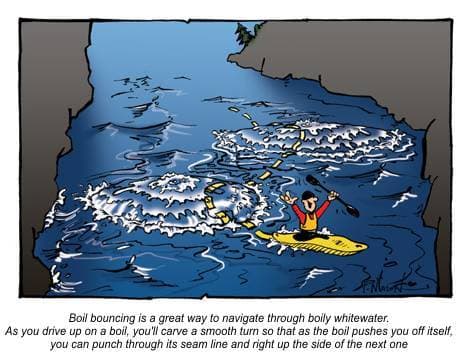Managing Boils
The following is a modified excerpt from Ken Whiting's book, 'The Ultimate Guide to Whitewater Kayaking'
A boil describes the action of water rising quickly to the surface and creating the appearance of boiling water. Boils are usually caused when too much water is being forced into one location. They'll often appear at the bottom of rapids, where the fast moving water runs into the slower moving water that is pooled. Similarly, they appear along walls that are being hit by current. In both cases, the oncoming water has nowhere to go, and so it gets pushed forcefully to the surface-and creates a boil. Once it hits the surface, this boiling water peaks and then runs off to the side to the lower-lying water around it. Where this shedding water hits the current around the boil, a seam line is created. These seam lines are largely what make boils one of the most unstable spots on the river. So, we're going to take a quick look at how to deal with them.
TAHE 10'6 & 11'6 SUP-YAK Inflatables
2-in-1 Kayak & Paddle Board complete packages for single or tandem use.
At this point, you should already know that you don't want to spend time on seam lines or eddy lines, where the water is unstable, so you'll want to either get yourself clear of the boil or break right across the seam line and on top of the boil. The key to tackling boils is to take them almost straight on (perpendicular to the seam line that you will be encountering) and with a slight ferry angle in the direction you'd like to go (usually downstream). As you break through the seam line and paddle on top of the boil, it will try its best to push you off to the side. You can use this energy to your advantage by carving a smooth turn on the boil and letting it push you off in the direction that you'd like to go. You'll need to have turned your kayak enough so that you can break through the next seam line at a fairly straight angle.
When there are multiple boils grouped together, you can even use this boil riding technique to bounce your way downriver, carving off the top of one boil and then the next. This boil bouncing technique is particularly helpful on big water rivers, or at the bottom of tidal rapids where you'll find a series of large boils.

Ken is a World Champion Kayaker and the author and producer of an award winning series of instructional kayaking books and videos. He was recognized by "Paddler Magazine" as one of their 'Paddlers of the Century'. For more information, visit www.helipress.com.
Related Articles
How many of you have ever heard that paddle craft (vessels under oars according to the Navigation Rules)…
Even though they are flipping over, missing their gates and failing their maneuvers, they still look…
Driving a car safely involves much more than merely focusing only as far ahead as the taillights of…
The following is a modified excerpt from Ken Whiting's book, 'The Ultimate Guide to Whitewater…




